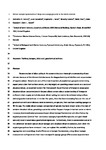Silicon isotopic systematics of deep-sea sponge grounds in the North Atlantic
| dc.contributor.author | Hendry, KR | |
| dc.contributor.author | Cassarino, L | |
| dc.contributor.author | Bates, SL | |
| dc.contributor.author | Culwick, T | |
| dc.contributor.author | Frost, M | |
| dc.contributor.author | Goodwin, C | |
| dc.contributor.author | Howell, Kerry | |
| dc.date.accessioned | 2019-07-03T11:44:38Z | |
| dc.date.issued | 2019-04-15 | |
| dc.identifier.issn | 0277-3791 | |
| dc.identifier.uri | http://hdl.handle.net/10026.1/14573 | |
| dc.description.abstract |
© 2019 Elsevier Ltd Reconstruction of silica cycling in the oceans is key to a thorough understanding of past climates because of the inherent links between the biogeochemistry of silicifiers and sequestration of organic carbon. Diatoms are one of the most important phytoplankton groups in determining export production from surface waters, and rely largely on upwelling deeper waters as a source of dissolved silicon, an essential nutrient for their growth. Quantification of changes in deep water dissolved silicon concentrations in the past allows a more robust understanding of changes in surface nutrient supply and whole-ocean silicon cycling, but cannot be achieved using surface-derived geochemical archives. In the last few years, there has been increasing focus on the use of geochemical archives in siliceous skeletal elements, or spicules, from seafloor-dwelling sponges to fill this gap. The stable silicon isotopic composition of spicules has been shown to be a function of ambient dissolved silicon, providing a potential archive for past changes in bottom water nutrients. However, biomineralisation processes impact silicon isotope fractionation and silica formed by atypical processes (derived from carnivorous sponges, hypersilicified spicules, and giant basal spicules) result in anomalous geochemical signatures. Furthermore, there is considerable scatter in the calibration between spicule silicon isotopes and dissolved silicon in seawater, even when the atypical groups have been removed. Here, we explore this variability further, by examining aggregation and assemblage-level differences in isotopic fractionation, using silicon isotopic measurements of specimens from two monospecific sponge groups (Pheronema carpenteri and Vazella pourtalesi), and one mixed-species population (genus Geodia) from the North Atlantic. Our new data reveal that variability within the monospecific aggregations is less than mixed-species assemblage, pointing towards a genetic control in isotopic fractionation. However, there is still variability within the monospecific aggregations, which cannot be explained by macroscale environmental differences: such variability is likely a reflection of the physiological health of the individuals, or highly localised heterogeneities in sponge habitats. Other challenges remain in the interpretation of spicule silicon isotopes as proxies for dissolved silicon changes through time, especially when investigating periods of Earth history that extend back considerably further than the residence time of dissolved silicon in the oceans. Despite all the questions still surrounding the use of sponge silicon isotopes in palaeoceanographic applications, they are still the only known archive of bottom water dissolved silicon. Continued efforts to understanding sponge biomineralisation and to incorporate silicon isotopes into oceanic models will help to improve further the reliability of the archive. | |
| dc.format.extent | 1-14 | |
| dc.language | en | |
| dc.language.iso | en | |
| dc.publisher | Elsevier | |
| dc.subject | Porifera | |
| dc.subject | Isotopes | |
| dc.subject | Silicic acid | |
| dc.subject | Geochemical archives | |
| dc.title | Silicon isotopic systematics of deep-sea sponge grounds in the North Atlantic | |
| dc.type | journal-article | |
| dc.type | Review | |
| dc.type | Journal | |
| plymouth.author-url | https://www.webofscience.com/api/gateway?GWVersion=2&SrcApp=PARTNER_APP&SrcAuth=LinksAMR&KeyUT=WOS:000465057500001&DestLinkType=FullRecord&DestApp=ALL_WOS&UsrCustomerID=11bb513d99f797142bcfeffcc58ea008 | |
| plymouth.volume | 210 | |
| plymouth.publication-status | Published | |
| plymouth.journal | Quaternary Science Reviews | |
| dc.identifier.doi | 10.1016/j.quascirev.2019.02.017 | |
| plymouth.organisational-group | /Plymouth | |
| plymouth.organisational-group | /Plymouth/Faculty of Science and Engineering | |
| plymouth.organisational-group | /Plymouth/Faculty of Science and Engineering/School of Biological and Marine Sciences | |
| plymouth.organisational-group | /Plymouth/REF 2021 Researchers by UoA | |
| plymouth.organisational-group | /Plymouth/REF 2021 Researchers by UoA/UoA07 Earth Systems and Environmental Sciences | |
| plymouth.organisational-group | /Plymouth/Research Groups | |
| plymouth.organisational-group | /Plymouth/Research Groups/Marine Institute | |
| plymouth.organisational-group | /Plymouth/Users by role | |
| plymouth.organisational-group | /Plymouth/Users by role/Academics | |
| plymouth.organisational-group | /Plymouth/Users by role/Researchers in ResearchFish submission | |
| dcterms.dateAccepted | 2019-02-15 | |
| dc.rights.embargodate | 2020-3-1 | |
| dc.rights.embargoperiod | Not known | |
| rioxxterms.versionofrecord | 10.1016/j.quascirev.2019.02.017 | |
| rioxxterms.licenseref.uri | http://www.rioxx.net/licenses/all-rights-reserved | |
| rioxxterms.licenseref.startdate | 2019-04-15 | |
| rioxxterms.type | Journal Article/Review |


